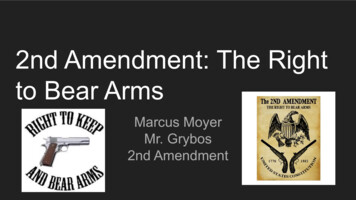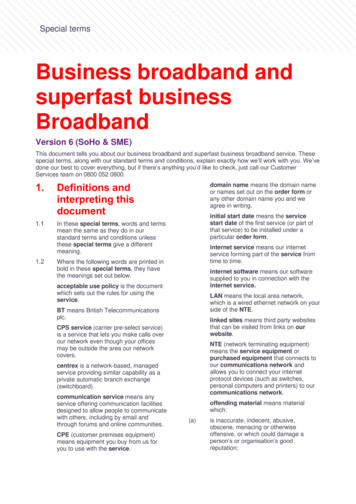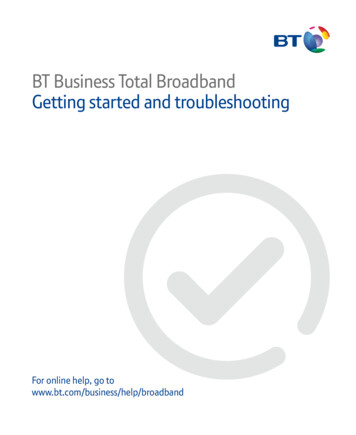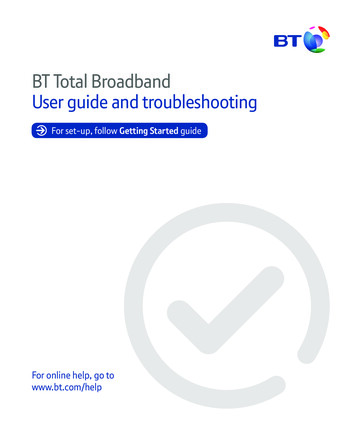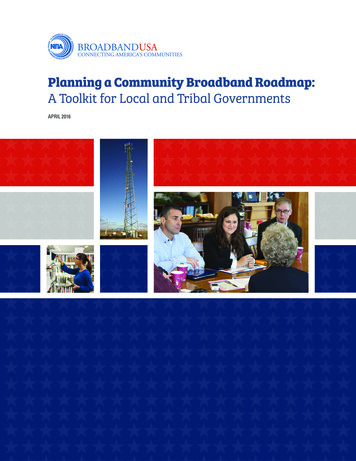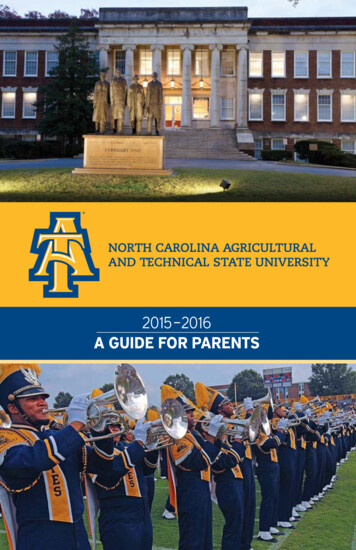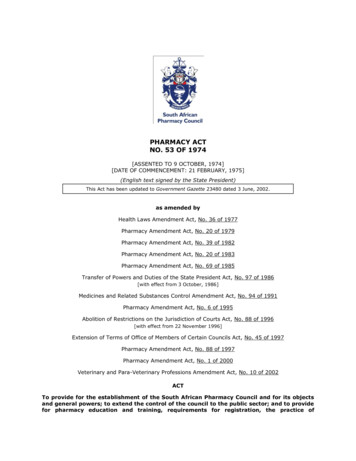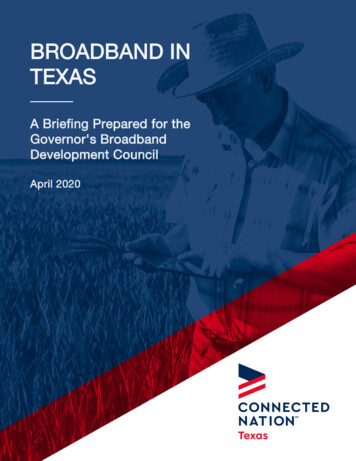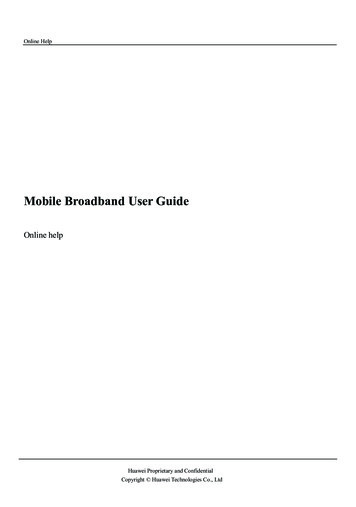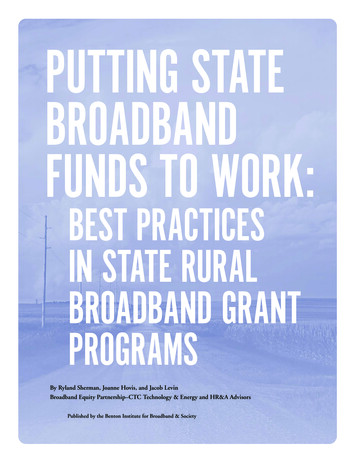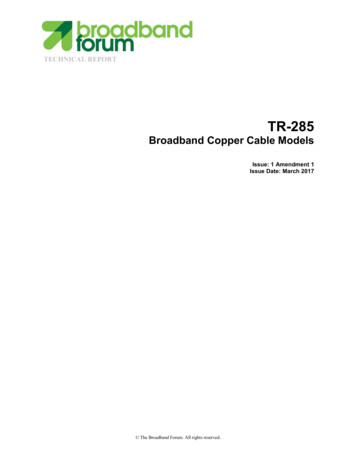
Transcription
TECHNICAL REPORTTR-285Broadband Copper Cable ModelsIssue: 1 Amendment 1Issue Date: March 2017 The Broadband Forum. All rights reserved.
Broadband Copper Cable ModelsTR-285 Issue 1 Amendment 1NoticeThe Broadband Forum is a non-profit corporation organized to create guidelines for broadbandnetwork system development and deployment. This Technical Report has been approved bymembers of the Forum. This Technical Report is subject to change. This Technical Report iscopyrighted by the Broadband Forum, and all rights are reserved. Portions of this Technical Reportmay be copyrighted by Broadband Forum members.Intellectual PropertyRecipients of this Technical Report are requested to submit, with their comments, notification ofany relevant patent claims or other intellectual property rights of which they may be aware thatmight be infringed by any implementation of this Technical Report, or use of any software codenormatively referenced in this Technical Report, and to provide supporting documentation.Terms of Use1. LicenseBroadband Forum hereby grants you the right, without charge, on a perpetual, non-exclusive andworldwide basis, to utilize the Technical Report for the purpose of developing, making, havingmade, using, marketing, importing, offering to sell or license, and selling or licensing, and tootherwise distribute, products complying with the Technical Report, in all cases subject to theconditions set forth in this notice and any relevant patent and other intellectual property rights ofthird parties (which may include members of Broadband Forum). This license grant does notinclude the right to sublicense, modify or create derivative works based upon the Technical Reportexcept to the extent this Technical Report includes text implementable in computer code, in whichcase your right under this License to create and modify derivative works is limited to modifying andcreating derivative works of such code. For the avoidance of doubt, except as qualified by thepreceding sentence, products implementing this Technical Report are not deemed to be derivativeworks of the Technical Report.2. NO WARRANTIESTHIS TECHNICAL REPORT IS BEING OFFERED WITHOUT ANY WARRANTYWHATSOEVER, AND IN PARTICULAR, ANY WARRANTY OF NONINFRINGEMENT ISEXPRESSLY DISCLAIMED. ANY USE OF THIS TECHNICAL REPORT SHALL BE MADEENTIRELY AT THE IMPLEMENTER'S OWN RISK, AND NEITHER THE BROADBANDFORUM, NOR ANY OF ITS MEMBERS OR SUBMITTERS, SHALL HAVE ANY LIABILITYWHATSOEVER TO ANY IMPLEMENTER OR THIRD PARTY FOR ANY DAMAGES OFANY NATURE WHATSOEVER, DIRECTLY OR INDIRECTLY, ARISING FROM THE USEOF THIS TECHNICAL REPORT.3. THIRD PARTY RIGHTSWithout limiting the generality of Section 2 above, BROADBAND FORUM ASSUMES NORESPONSIBILITY TO COMPILE, CONFIRM, UPDATE OR MAKE PUBLIC ANY THIRDPARTY ASSERTIONS OF PATENT OR OTHER INTELLECTUAL PROPERTY RIGHTSTHAT MIGHT NOW OR IN THE FUTURE BE INFRINGED BY AN IMPLEMENTATION OFTHE TECHNICAL REPORT IN ITS CURRENT, OR IN ANY FUTURE FORM. IF ANY SUCHMarch 2017 The Broadband Forum. All rights reserved2 of 26
Broadband Copper Cable ModelsTR-285 Issue 1 Amendment 1RIGHTS ARE DESCRIBED ON THE TECHNICAL REPORT, BROADBAND FORUM TAKESNO POSITION AS TO THE VALIDITY OR INVALIDITY OF SUCH ASSERTIONS, OR THATALL SUCH ASSERTIONS THAT HAVE OR MAY BE MADE ARE SO LISTED.The text of this notice must be included in all copies of this Technical Report.March 2017 The Broadband Forum. All rights reserved3 of 26
Broadband Copper Cable ModelsTR-285 Issue 1 Amendment 1Issue HistoryIssueNumber1.00Approval DatePublication DateIssue EditorChanges13 March 20175 May 2017Andre HolleyTELUS Communications.OriginalComments or questions about this Broadband Forum Technical Report should be directed tohelp@broadband-forum.org.EditorAndre HolleyTELUSCommunicationsandreholley@telus.netWork AreaDirector(s)Les BrownHuaweiTechnologieslesbrown@sympatico.caMarch 2017 The Broadband Forum. All rights reserved4 of 26
Broadband Copper Cable ModelsTR-285 Issue 1 Amendment 1TABLE OF CONTENTSEXECUTIVE SUMMARY . 71PURPOSE AND SCOPE . 81.11.21.31.41.51.62PURPOSE. 8SCOPE. 8CONVENTIONS . 8REFERENCES . 9THE FOLLOWING DEFINITIONS ARE USED THROUGHOUT THIS TECHNICAL REPORT. . 10ABBREVIATIONS . 10TECHNICAL REPORT IMPACT . 112.12.22.32.4ENERGY EFFICIENCY . 11IPV6 . 11SECURITY . 11PRIVACY. 11ANNEX C: REFERENCE CABLE MODELS FOR QUAD CABLE DEPLOYED BYEUROPEAN OPERATORS. 12C.1REFERENCE CABLE MODEL FOR PE4D-ALT 4X10X0.6MM QUAD CABLE . 12C.1.1Insertion Loss . 12C.1.2ELFEXT . 12C.2REFERENCE CABLE MODEL FOR P-PB 4X10X0.6MM QUAD CABLE . 17C.2.1Insertion Loss . 17C.2.2ELFEXT . 17ANNEX D: COAX CABLE CONFIGURATION BASED ON NORTH AMERICAN USECASES / APPLICATIONS. . 22D.1COAX CABLE CONFIGURATION AND MODELING . 22March 2017 The Broadband Forum. All rights reserved5 of 26
Broadband Copper Cable ModelsTR-285 Issue 1 Amendment 1List of FiguresFigure 1: ELFEXT Phases for PE4D-ALT 10x40x0.6mm, 100m cable. 13Figure 2: Statistical Dual Slope ELFEXT Model for 100m PE4D-ALT 4x10x0.6mm Cable . 15Figure 3: Statistical Dual Slope ELFEXT Model for PE4D-ALT 4x10x.06mm Cable. Mean Valuesfor 50m and 100m . 16Figure 4: ELFEXT Phases for the P-Pb 1-x4x0.6mm, 100m cable . 18Figure 5: Statistical Dual Slope ELFEXT Model for 100m P-Pb 4x10x0.6mm Cable . 20Figure 6: Statistical Dual Slope ELFEXT Model for P-Pb 4x10x0.6mm Cable . 21Figure 7: Coax configuration for G.fast with Satellite TV. 22Figure 8: Coax configuration with G.fast only . 22Figure 9: Exponential Approximation of Coax Insertion Loss vs. Frequency for RG-6. . 23Figure 10: Exponential Approximation of Coax Insertion Loss vs. Frequency for RG-59. . 24Figure 11: Exponential Approximation of Coax Insertion Loss vs. Frequency for RG-59. . 24Figure 12: Typical Cable Construction [3] . 25Figure 13: RLGC Circuit model for Coax Cable . 26List of TablesTable 1: ITU-T Single Line Model for PE4D-ALT 10x4x0.6mm . 12Table 2: PE4D-ALT 4x10x0.6mm Cable Parameters . 14Table 3: Calculatedfrom the parameters in Table 1 . 14Table 4: ITU-T Single Line Model for P-Pb 10x4x0.6mm cable . 17Table 5: P-Pb 4x10x0.6mm Cable Parameters . 19Table 6: Calculatedfrom the parameters in Table 5 . 19Table 7: Insertion Loss Characteristic of Coax cable Types [2] . 23Table 8: Exponential Approximation of Coax Cable Insertion Loss Coefficients. 24Table 9: Typical Coax Characteristic [3] . 25March 2017 The Broadband Forum. All rights reserved6 of 26
Broadband Copper Cable ModelsTR-285 Issue 1 Amendment 1Executive SummarySee Executive Summary/TR-285.New reference cable models added:1. Polyethylene-foam insulated plant quad structured cable and Paper-air insulated 2 layered starquad cables as deployed by various European network operators, in Annex C2. Coax cable and configurations based on North American use cases, in Annex DMarch 2017 The Broadband Forum. All rights reserved7 of 26
Broadband Copper Cable Models1TR-285 Issue 1 Amendment 1Purpose and Scope1.1 PurposeThe purpose of this Technical Report is to support the development of testing capabilities atfrequencies above 30 MHz by providing detailed models of copper cables. This work complementsemerging specifications for G.fast access technology and FTTdp transmission deployment.1.2ScopeThis Technical Report focuses on the subject of modeling copper cables at frequencies above 30MHz. This Technical Report provides models that can be used in Broadband Forum specificationsfor testing of G.fast implementations.These models include the single line parameters, the transfer function of the direct path, the transferfunction of the FEXT coupling, and the input impedance of the line.This Technical Report addresses the cable that extends from the Distribution Point (DP) to theNetwork Interface Device (NID) at the Customer Premises.1.3 ConventionsIn this Technical Report, several words are used to signify the requirements of the specification.These words are always capitalized. More information can be found be in RFC 2119 [1].MUSTThis word, or the term “REQUIRED”, means that the definition is anabsolute requirement of the specification.MUST NOTThis phrase means that the definition is an absolute prohibition of thespecification.SHOULDThis word, or the term “RECOMMENDED”, means that there couldexist valid reasons in particular circumstances to ignore this item, butthe full implications need to be understood and carefully weighedbefore choosing a different course.SHOULD NOT This phrase, or the phrase "NOT RECOMMENDED" means that therecould exist valid reasons in particular circumstances when theparticular behavior is acceptable or even useful, but the fullimplications need to be understood and the case carefully weighedbefore implementing any behavior described with this label.MAYMarch 2017This word, or the term “OPTIONAL”, means that this item is one ofan allowed set of alternatives. An implementation that does notinclude this option MUST be prepared to inter-operate with anotherimplementation that does include the option. The Broadband Forum. All rights reserved8 of 26
Broadband Copper Cable ModelsTR-285 Issue 1 Amendment 11.4 ReferencesThe following references are of relevance to this Technical Report. At the time of publication, theeditions indicated were valid. All references are subject to revision; users of this Technical Reportare therefore encouraged to investigate the possibility of applying the most recent edition of thereferences listed below.A list of currently valid Broadband Forum Technical Reports is published 1] RFC 2119Key words for use in RFCs to indicateRequirement Levels [2]BBF1997[2] Jon FreemanFundamentals of Microwave Transmission LinesWiley1996Interscience[3] David Large,James FarmerBroadband Cable Access Networks – Chapter 2MorganKaufmannMarch 2017 The Broadband Forum. All rights reserved20099 of 26
Broadband Copper Cable ModelsTR-285 Issue 1 Amendment 11.5 The following definitions are used throughout this Technical Report.See Definitions / TR-285i11.6 AbbreviationsSee Abbreviations / TR-285i1DMTFTU-OELFEXTFTU-RILMAERG-xDiplexerMarch 2017Discrete Multi-ToneFTU at the Optical Network Unit (i.e., operator end of the loop)Equal Length Far End CrosstalkFTU at the Remote site (i.e., subscriber end of the loop)Insertion LossMean Absolute ErrorRadio Guide – Standard Coaxial Cable designations.A two port to one port multiplexer The Broadband Forum. All rights reserved10 of 26
Broadband Copper Cable Models2TR-285 Issue 1 Amendment 1Technical Report Impact2.1 Energy EfficiencyTR-285 has no impact on energy efficiency2.2 IPv6TR-285 has no impact on IPv6.2.3 SecurityTR-285 has no impact on security.2.4 PrivacyAny issues regarding privacy are not affected by TR-285.March 2017 The Broadband Forum. All rights reserved11 of 26
Broadband Copper Cable ModelsTR-285 Issue 1 Amendment 1Annex C: Reference Cable Models for Quad Cable Deployed by EuropeanOperators.C.1 Reference Cable Model for PE4D-ALT 4x10x0.6mm Quad CableThe PE4D-ALT 4x10x0.6mm is a polyethylene-foam insulated 2-layered star quad cable withaluminum cable mantle deployed since the early 1990’s. It consists of 2 core and 8 outer quads.C.1.1 Insertion LossInsertion Loss (IL) is described by the ITU-T single line model. The parameter values for themulti-pair approximation are given in Table 1. The model describes accurately magnitude andphase of the Insertion Loss.ITU-T ModelTable 1: ITU-T Single Line Model for PE4D-ALT 10x4x0.6mmηVF Rs0qLqH qx qyqcZ0 PE4D-ALT 10x4x0.6mm1300.7350.1252.50.75100 fd0.00711C.1.2 ELFEXTThe ELFEXT magnitude is described by a dual slope model. The lower slope has 20dB/decadesteepness; the upper slope has 40dB/decade steepness. The model assumes homogeneity andlinearity over the full cable length. It is expressed by the following formula: {WhereThe ELFEXT phase is described by the following model.March 2017 The Broadband Forum. All rights reserved12 of 26
Broadband Copper Cable ModelsTR-285 Issue 1 Amendment 1For inductive coupling: ELFEXT phase from pair k to pair l: ELFEXT phase from pair l to pair k:For capacitive coupling: ELFEXT phase from pair k to pair l: ELFEXT phase from pair l to pair k:Where for in-quad pairings:for inter-quad pairings:one half of the pairings have capacitive coupling and the other half inductive coupling.The figure below illustrates the ELFEXT phase model.Figure 1: ELFEXT Phases for PE4D-ALT 10x40x0.6mm, 100m cableGiven by the large variability of crosstalk observed between different crosstalk pairings in the cable,a statistical approach is used by indicating mean and 95-percentile parameter values. Since in-quadand inter-quad crosstalk differ considerably, parameter values are indicated separately for bothcases. For the PE4D-ALT 4x10x0.6mm cable model all parameters are given in Table 2:March 2017 The Broadband Forum. All rights reserved13 of 26
Broadband Copper Cable ModelsTR-285 Issue 1 Amendment 1Table 2: PE4D-ALT 4x10x0.6mm Cable ParametersELFEXT inter-quad pairingsELFEXT in-quad e-204 dB-189 dB-195 dB-187 dB-362 dB-340 dB-340 dB-334 0.12dB/m0.12dB/mFor both, inter-quad and in-quad pairings, independent normal distributions for the values ofandin dB can be assumed.From the model parameters given aboveand 100m:is calculated as an example for the two cable lengths 50Table 3: Calculatedfrom the parameters in Table 1ELFEXT inter-quad pairingsELFEXT in-quad eat 50m56 MHz25 MHz13 MHz16 MHzat 100m40 MHz18 MHz9 MHz11 MHzSince the number of inter-quad pairings is dominant in the 4x10x0.6mm PE4D cable, the statisticalparameter values over all pairings of the PE4D-ALT 4x10x0.6mm cable, compared to those overinter-quad pairings only, are approximately equal.To build a complete quad cable ELFEXT model, both, an in-quad and an inter-quad crosstalk modelis necessary. Even if the share of in-quad crosstalk pairings in a cable is small, in-quad crosstalkstill plays a dominant role for self-FEXT cancellation systems (vectoring).Figure 2 shows the model curves for 100m cable length:March 2017 The Broadband Forum. All rights reserved14 of 26
Broadband Copper Cable ModelsTR-285 Issue 1 Amendment 1Figure 2: Statistical Dual Slope ELFEXT Model for 100m PE4D-ALT 4x10x0.6mm CableMarch 2017 The Broadband Forum. All rights reserved15 of 26
Broadband Copper Cable ModelsTR-285 Issue 1 Amendment 1Figure 3 compares the mean value model curves for 50m and 100m cable length:Figure 3: Statistical Dual Slope ELFEXT Model for PE4D-ALT 4x10x.06mm Cable.Mean Values for 50m and 100mThe ELFEXT model given reflects the following quad cable crosstalk characteristics, consistentlyfound in experimental cable data: In-quad crosstalk is typically higher than inter-quad crosstalkThe dual slope transition frequency of in-quad crosstalk is typically lower than that forinter-quad crosstalkThe dual slope transition frequency decreases with cable lengthOverall, higher electromagnetic coupling between two pairs means lower dual slope transitionfrequency .March 2017 The Broadband Forum. All rights reserved16 of 26
Broadband Copper Cable ModelsTR-285 Issue 1 Amendment 1C.2 Reference Cable Model for P-Pb 4x10x0.6mm Quad CableThe P-Pb 4x10x0.6mm is a paper-air insulated 2-layered star quad cable with lead cable mantle,which used to be deployed mostly in European networks until the 1990’s. It consists of 2 core and8 outer quads.C.2.1 Insertion LossInsertion Loss (IL) is described by the ITU-T single line model. The parameter values for themulti-pair approximation are given in Table 4. The model describes accurately magnitude andphase of Insertion Loss.ITU-T ModelTable 4: ITU-T Single Line Model for P-Pb 10x4x0.6mm cableηVF Rs0qLqH qx qyqcZ0 P-Pb 10x4x0.6mm1300.7350.1251.50.75200 fd0.0131Note: The parameters given above correspond to non-deployed cables under lab conditions. It ishowever known that Insertion Loss of paper-air insulated cables may increase considerably whendeployed and not protected sufficiently from humidity.C.2.2 ELFEXTThe ELFEXT magnitude is described by a dual slope model. The lower slope has 20dB/decadesteepness; the upper slope has 40dB/decade steepness. The model assumes homogeneity andlinearity over the full cable length. It is expressed by the following formula: {WhereThe ELFEXT phase is described by the following model:March 2017 The Broadband Forum. All rights reserved17 of 26
Broadband Copper Cable ModelsTR-285 Issue 1 Amendment 1For inductive coupling: ELFEXT phase from pair k to pair l: ELFEXT phase from pair l to pair k:For capacitive coupling: ELFEXT phase from pair k to pair l: ELFEXT phase from pair l to pair k:Where for in-quad pairings:for inter-quad pairings:one half of the pairings have capacitive coupling and the other half inductive coupling.The figure below illustrates the ELFEXT phase model.Figure 4: ELFEXT Phases for the P-Pb 1-x4x0.6mm, 100m cableSince the number of inter-quad pairings is dominant in the P-Pb 4x10x0.6mm cable, the statisticalparameter values over all pairings of the P-Pb 4x10x0.6mm cable, compared to those over interquad pairings only, are approximately equal. However, to build a complete quad cable ELFEXTmodel, both, an in-quad and an inter-quad crosstalk model is necessary. Even if the share of inquad crosstalk pairings in a cable is small, in-quad crosstalk still plays a dominant role for selfFEXT cancellation systems (vectoring).March 2017 The Broadband Forum. All rights reserved18 of 26
Broadband Copper Cable ModelsTR-285 Issue 1 Amendment 1Given by the large variability of crosstalk observed between different crosstalk pairings in the cable,a statistical approach is used by indicating mean and 95-percentile parameter values.For the P-Pb 4x10x0.6mm cable model all parameters are given in Table 5:Table 5: P-Pb 4x10x0.6mm Cable ParametersELFEXT inter-quad pairingsELFEXT in-quad e-195 dB-177 dB-188 dB-179 dB-349 dB-333 dB-329 dB-302 0.12dB/m0.12dB/mNote: The parameters given above correspond to a non-deployed cable under lab conditions. It ishowever known that Crosstalk of paper-air insulated cables may increase considerably whendeployed and not protected sufficiently from humidity.For both, inter-quad and in-quad pairings, independent normal distributions for the values ofandin dB can be assumed.From the model parameters given aboveand 100m:is calculated as an example for the two cable lengths 50Table 6: Calculatedfrom the parameters in Table 5ELFEXT inter-quad pairingsELFEXT in-quad eat 50m35 MHz45 MHz8 MHz1 MHzat 100m25 MHz32 MHz6 MHz1 MHzMarch 2017 The Broadband Forum. All rights reserved19 of 26
Broadband Copper Cable ModelsTR-285 Issue 1 Amendment 1Figure 5 shows the model curves for 100m cable length:Figure 5: Statistical Dual Slope ELFEXT Model for 100m P-Pb 4x10x0.6mm CableMarch 2017 The Broadband Forum. All rights reserved20 of 26
Broadband Copper Cable ModelsTR-285 Issue 1 Amendment 1Figure 6 compares the mean value model curves for 50m and 100m cable length:Figure 6: Statistical Dual Slope ELFEXT Model for P-Pb 4x10x0.6mm CableThe ELFEXT model given reflects the following quad cable crosstalk characteristics, consistentlyfound in experimental cable data: In-quad crosstalk is typically higher than inter-quad crosstalkThe dual slope transition frequency of in-quad crosstalk is typically lower than that forinter-quad crosstalkThe dual slope transition frequency decreases with cable lengthOverall, higher electromagnetic coupling between two pairs means lower dual slope transitionfrequency .March 2017 The Broadband Forum. All rights reserved21 of 26
Broadband Copper Cable ModelsTR-285 Issue 1 Amendment 1Annex D: Coax Cable Configuration Based on North American Use Cases /Applications.D.1 Coax Cable Configuration and ModelingIn Figure 7 and Figure 8 all cable sections are RG6 type coax and all connectors are F type.Polyethylene foam is used for coax insulation; the center conductor may be copper-clad steel.FTU-O at DP5mDiplexer200m max50 m typicalRG6 coaxG.fastCommonSatelliteAntenna Amp.Diplexer10mFTU-R at RGG.fastCommonSat.Sat.Set top boxFigure 7: Coax configuration for G.fast with Satellite TVFigure 8: Coax configuration with G.fast onlyBoth diplexers have identical characteristics. There are typically no splitters or bridged taps in theG.fast path. There are no in-line amplification devices in the G.fast or satellite signal path. Thesignals at the Satellite port reside at 2.3 MHz and 950 to 2150 MHz.Typical diplexer characteristics from G.fast port to Common port:Passband:Insertion loss:0-0.5 and 5-806 MHz5 dB from 30 kHz to 500 kHz4 dB from 4 to 5 MHz2 dB from 6 to 7 MHz1.5 dB from 6 to 212 MHz2.5 dB 212 to 806 MHz 40 dB out of bandReturn loss with all ports terminated with 75 ohms: 10 dBMarch 2017 The Broadband Forum. All rights reserved22 of 26
Broadband Copper Cable ModelsTR-285 Issue 1 Amendment 1The coax cable signal loss characteristics in dB per 100m are shown in Table 7Table 7: Insertion Loss Characteristic of Coax cable Types [2]1 MHz10 MHz50 MHz100 MHz200 MHz400 MHz700 MHz900 MHz1000 MHz2150 .47IL (dB)/ 1.65The maximum distance of the coax deployment is modeled by RG-6 cable is shown in Figure 7 andFigure 8. A longer coax deployment distance is possible by utilizing the lower loss RG-11 cable.Conversely, the maximum coax distance could be reduced with RG-59 cable to the equivalent lossdistance of the RG-6.The exponential approximation of the coax insertion loss characteristic is given by:IL a f b c f d(dB/100m)f Frequency in MHzFigure 9: Exponential Approximation of Coax Insertion Loss vs. Frequency for RG-6.March 2017 The Broadband Forum. All rights reserved23 of 26
Broadband Copper Cable ModelsTR-285 Issue 1 Amendment 1Figure 10: Exponential Approximation of Coax Insertion Loss vs. Frequency for RG-59.Figure 11: Exponential Approximation of Coax Insertion Loss vs. Frequency for RG-59.The approximation coefficients for each of the coax cable are given in Table 8 below with MAE(Mean Absolute Error) 0.5 dB within 1GHz band.Table 8: Exponential Approximation of Coax Cable Insertion Loss arch 820 The Broadband Forum. All rights reserved24 of 26
Broadband Copper Cable ModelsTR-285 Issue 1 Amendment 1In addition to the attenuation approximation, there are interests in simulating the time domainmodels of the coaxial cable based on circuit analysis.Figure 12: Typical Cable Construction [3]D the inner diameter of the shieldd the outer diameter of the core conductorThe characteristic impedance of the coaxial cable can be calculated as( ) Whereεr the relative dielectric constant of the dielectric between the outer shield and the coreCable TypeRG-6RG-59RG-11d (mm)1.0240.581.63Table 9: Typical Coax Characteristic [3]D (mm)Z0 /m)536766Vp0.830.680.84The relative propagation velocity is the ratio between velocity in cable and the free-space velocitywhich is near the speed of light at 3 x 108 m/sec or 984 ft / µs. The R,L,G,C parameters could be derived from these basic circuit elements for construction of theimpulse response of the coaxial cable similar to what is done for the twisted-pair cable.March 2017 The Broadband Forum. All rights reserved25 of 26
Broadband Copper Cable ModelsL TR-285 Issue 1 Amendment 1( ) C ( );G 0Figure 13: RLGC Circuit model for Coax CableNote: The relative permeability (µr) of the copper and aluminum used in typical coax cable (such as RG-6,RG-11 and RG-59) approximately equals to 1End of Broadband Forum Technical Report TR-285 Issue 1 Amendment 1March 2017 The Broadband Forum. All rights reserved26 of 26
TELUS Communications. Original Comments or questions about this Broadband Forum Technical Report should be directed to help@broadband-forum.org. Editor Andre Holley TELUS Communications andreholley@telus.net Work Area Director(s) Les Brown Huawei Technologies lesbrown@sympatico.ca
